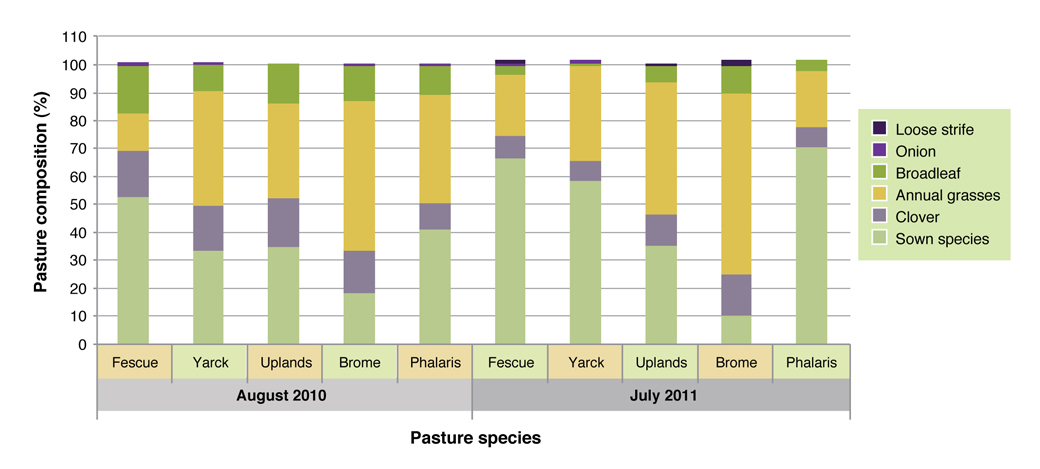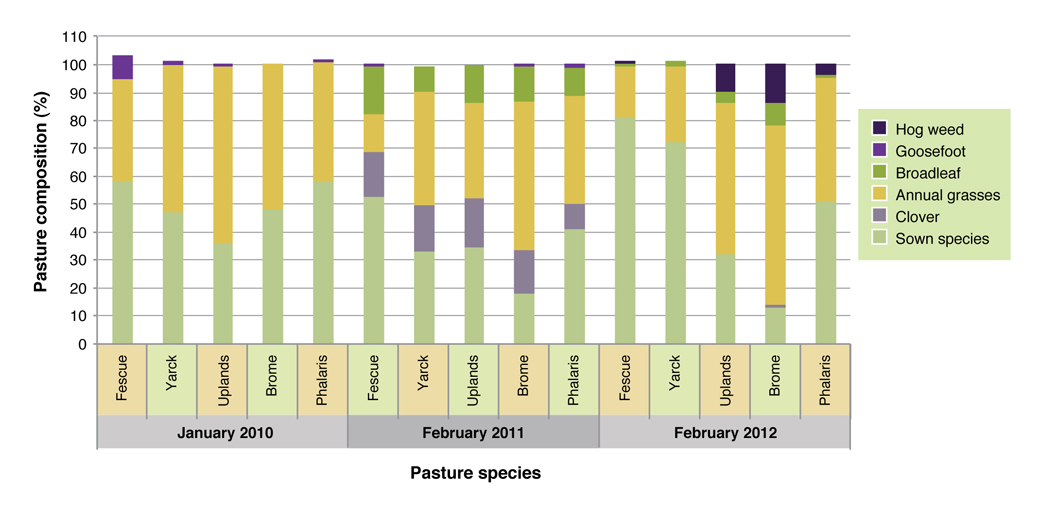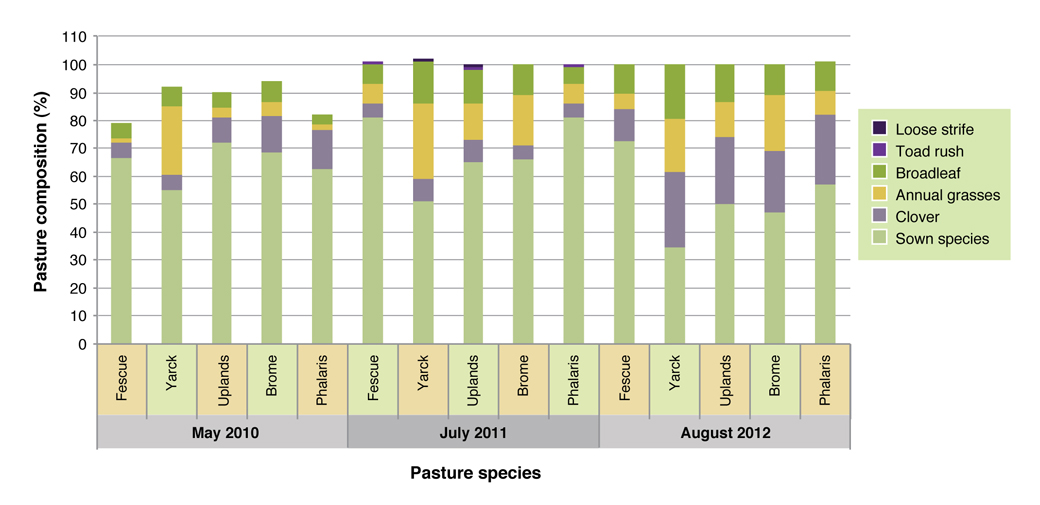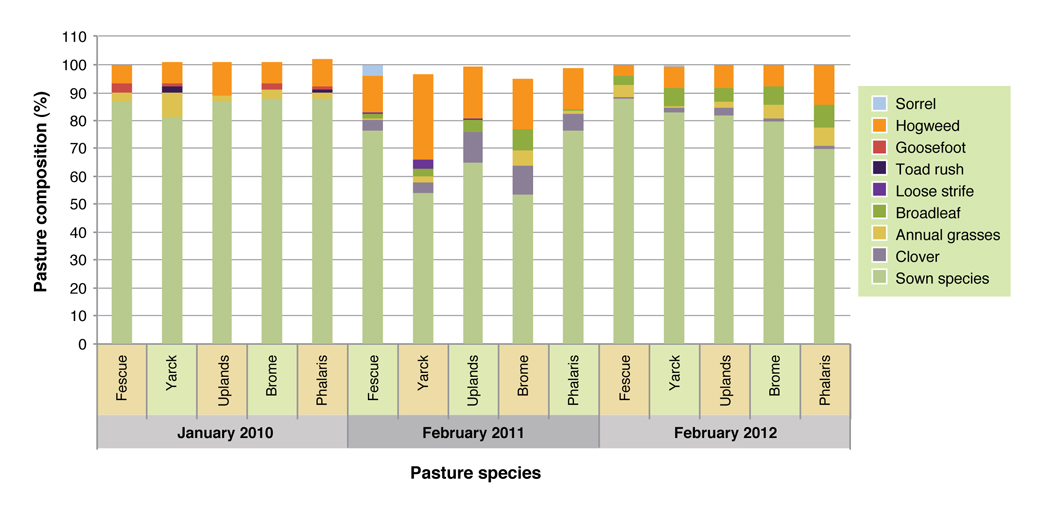Euroa MLA Producer Demonstration Site – Composition and Persistence
Composition and persistence at Longwood
Pasture composition (Figures 1 and 2) gives some indication of persistence of the perennials. In addition to composition reported below, a final plant count will take place in autumn 2013. The experiment would need to run for several more years to indicate long-term persistence.
Phalaris, Yarck cocksfoot and winter active fescue persisted well into the fourth year at Longwood, making up 50%, 70% and 80% of the composition in summer 2012 (Figure 2). The Uplands cocksfoot and brome never recovered from a slow establishment and had lower plant numbers and higher annual grass burdens for the duration of the demonstration.


Winter cleaning worked in strong stands
In late August 2010, the Longwood site was winter cleaned with simazine and gramoxone to target silver grass, and was grazed heavily to prevent further seeding. The spraying was effective in the Yarck cocksfoot, fescue and phalaris where the perennials were dense enough to compete (Figure 1).
Challenges to persistence – pugging, waterlogging and under-grazing
The wet spring in 2010 resulted in significant pugging across the Longwood site (Figure 3). This was particularly evident in the Uplands and brome which had lower densities of perennials. Similarly, while phalaris thrived in the floods of 2011, the cocksfoots did not tolerate the water logging (Figure 4).
Pugging also restricted heavy grazing in the Uplands after spraying in 2010, which hampered silver grass control. Lack of grazing during the spring/summer of 2011-12 (while the property was being sold) also resulted in further increases in the annual grass burden in the brome and Uplands. It is likely that these plots would need to be re-sown.


Ongoing benefits from good establishment at Euroa
The excellent establishment, high fertility and rotational grazing resulted in good perennial density and low weed burden for all five species for the duration of the demonstration at Euroa (Figures 5 and 6).
Overall the fescue and the phalaris plots persisted really well, with good strong stands. Even though the fescue had a lower percentage of clover than the other plots, it appeared that the sown species was making up most of the composition. The Yarck cocksfoot was the poorest performing, struggling with competition and survival in the lighter soils through summer.
Poor seed set in 2009 and 2010 resulted in very low clover levels in 2010 and 2011. In 2012, clover increased across all plots from 6% in 2011, to twenty percent in 2012 (Figure 5). Higher clover content was seen across the district that year and was likely a result of good seeding and germination conditions that year. Spraying out broadleaf weeds from the plots in late winter may have also increased competitiveness of the clover.


High feed quality from perennials
During 2010, feed quality was measured on all plots, in addition to the ryecorn and chicory. A selection of results is presented in Table 1.
Table 1. Feed test results (2010)
| Control | Phalaris | Chicory | Tall Fescue | Ryecorn (second year) | |
| May energy (MJ/kg) |
9.8 |
11 |
11.8 |
12.2 |
12.2 |
| May protein (%) |
16 |
23.5 |
32 |
25 |
28 |
| May NDF (%) |
55 |
50 |
28 |
43 |
45 |
| Late October energy (MJ/kg) |
8.8 |
10.7 |
10.4 |
9.3 |
|
| Late October protein (%) |
10.7 |
17.4 |
19.1 |
13.6 |
|
| October NDF (%) |
56 |
52 |
40 |
58 |
The control, dominated by annual grasses and weeds, had lower energy and protein than the sown perennials in both May and October. The difference of 2 MJ/kg metabolisable energy between the control and the sown species is equivalent to approximately 0.5 kg/hd/day weight gain. The tall fescue showed a drop in energy earlier than the phalaris, with a difference of 1.5 MJ/kg ME and 5% protein in the October measurements. This was expected given the fescue went through senescence at least three weeks earlier than the other sown species in the demonstration. The chicory had very high energy and protein in both May and October, however neutral detergent fibre levels in May were below 35% which is recommended as a minimum for cattle. Therefore, hay needs to be fed while grazing cattle on chicory through winter. The ryecorn had high feed quality in its second year (after regerminating) while it was grazed in May.
Acknowledgements
Thanks to the site hosts Andrew and Caroline Walta and John and Mary Kelly for hosting the sites, managing the cattle movements, recording weights, rainfall, grazing data and above all their commitment and passion to this project. Thanks also to the members of the Euroa Grazing Group – the project would not have been such a success without the drive and enthusiasm of the group.
This project was funded by Meat and Livestock Australia (MLA) and the Agriculture Victoria as part of the MLA Producer Demonstration Site initiative. Significant linkages were made to the BESTWOOL-BESTLAMB and EverGraze project extension for the project. Smyth Seeds and Stephens Pasture Seeds provided seed for the trial sites.
Further Information
- Full report – Euroa Producer Demonstration Site
- Case study – Flexible approach fills the gap
- Case study- Perennials increasing productivity
- The place, purpose and management of perennials – Euroa Producer Demonstration Site, Grasslands Society Conference Proceedings 2011
- A simple guide to pasture establishment
- EverGraze Action – Growing and using Chicory on the East Coast
- EverGraze Action – Grazing Phalaris for production and persistence
- EverGraze Action – Growing and using winter active tall fescue in southern Australia
- Primefact – Cocksfoot

